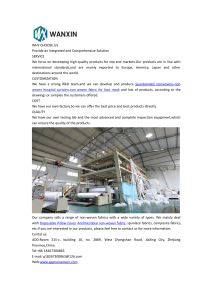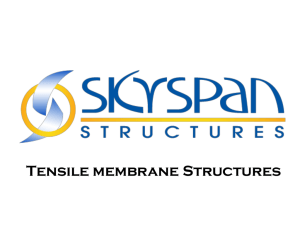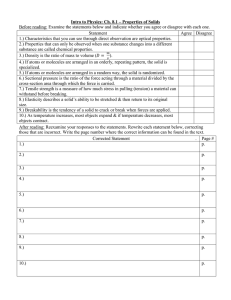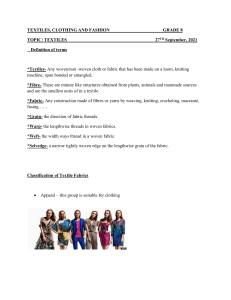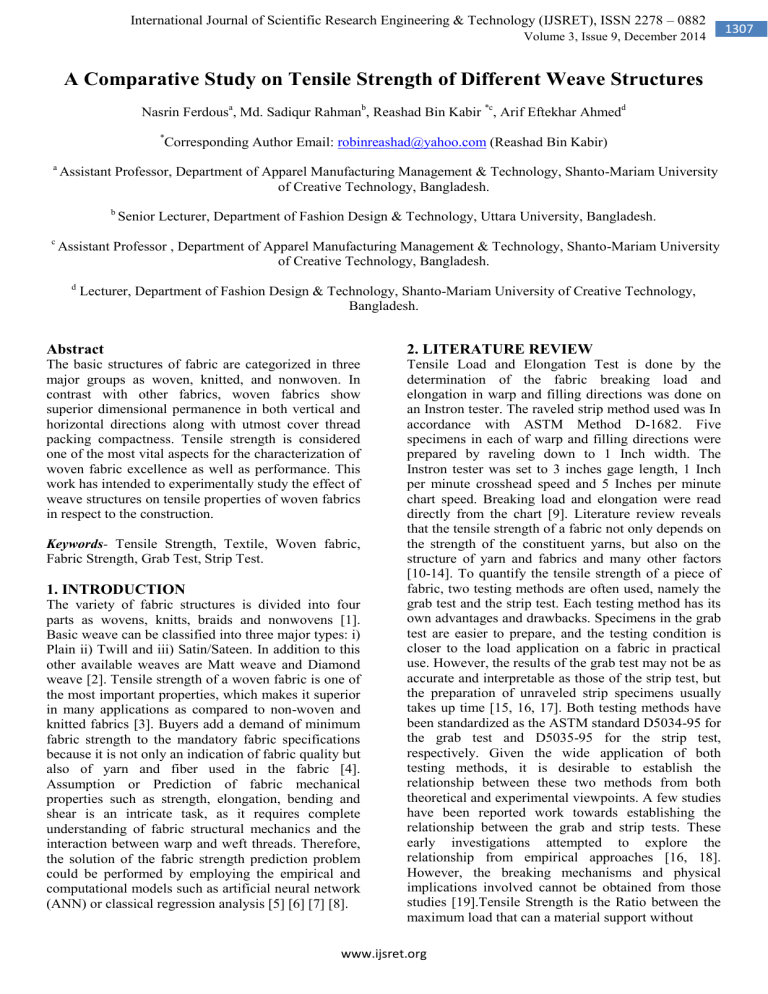
International Journal of Scientific Research Engineering & Technology (IJSRET), ISSN 2278 – 0882 Volume 3, Issue 9, December 2014 A Comparative Study on Tensile Strength of Different Weave Structures Nasrin Ferdousa, Md. Sadiqur Rahmanb, Reashad Bin Kabir *c, Arif Eftekhar Ahmedd * Corresponding Author Email: robinreashad@yahoo.com (Reashad Bin Kabir) a Assistant Professor, Department of Apparel Manufacturing Management & Technology, Shanto-Mariam University of Creative Technology, Bangladesh. b c Senior Lecturer, Department of Fashion Design & Technology, Uttara University, Bangladesh. Assistant Professor , Department of Apparel Manufacturing Management & Technology, Shanto-Mariam University of Creative Technology, Bangladesh. d Lecturer, Department of Fashion Design & Technology, Shanto-Mariam University of Creative Technology, Bangladesh. Abstract 2. LITERATURE REVIEW The basic structures of fabric are categorized in three major groups as woven, knitted, and nonwoven. In contrast with other fabrics, woven fabrics show superior dimensional permanence in both vertical and horizontal directions along with utmost cover thread packing compactness. Tensile strength is considered one of the most vital aspects for the characterization of woven fabric excellence as well as performance. This work has intended to experimentally study the effect of weave structures on tensile properties of woven fabrics in respect to the construction. Tensile Load and Elongation Test is done by the determination of the fabric breaking load and elongation in warp and filling directions was done on an Instron tester. The raveled strip method used was In accordance with ASTM Method D-1682. Five specimens in each of warp and filling directions were prepared by raveling down to 1 Inch width. The Instron tester was set to 3 inches gage length, 1 Inch per minute crosshead speed and 5 Inches per minute chart speed. Breaking load and elongation were read directly from the chart [9]. Literature review reveals that the tensile strength of a fabric not only depends on the strength of the constituent yarns, but also on the structure of yarn and fabrics and many other factors [10-14]. To quantify the tensile strength of a piece of fabric, two testing methods are often used, namely the grab test and the strip test. Each testing method has its own advantages and drawbacks. Specimens in the grab test are easier to prepare, and the testing condition is closer to the load application on a fabric in practical use. However, the results of the grab test may not be as accurate and interpretable as those of the strip test, but the preparation of unraveled strip specimens usually takes up time [15, 16, 17]. Both testing methods have been standardized as the ASTM standard D5034-95 for the grab test and D5035-95 for the strip test, respectively. Given the wide application of both testing methods, it is desirable to establish the relationship between these two methods from both theoretical and experimental viewpoints. A few studies have been reported work towards establishing the relationship between the grab and strip tests. These early investigations attempted to explore the relationship from empirical approaches [16, 18]. However, the breaking mechanisms and physical implications involved cannot be obtained from those studies [19].Tensile Strength is the Ratio between the maximum load that can a material support without Keywords- Tensile Strength, Textile, Woven fabric, Fabric Strength, Grab Test, Strip Test. 1. INTRODUCTION The variety of fabric structures is divided into four parts as wovens, knitts, braids and nonwovens [1]. Basic weave can be classified into three major types: i) Plain ii) Twill and iii) Satin/Sateen. In addition to this other available weaves are Matt weave and Diamond weave [2]. Tensile strength of a woven fabric is one of the most important properties, which makes it superior in many applications as compared to non-woven and knitted fabrics [3]. Buyers add a demand of minimum fabric strength to the mandatory fabric specifications because it is not only an indication of fabric quality but also of yarn and fiber used in the fabric [4]. Assumption or Prediction of fabric mechanical properties such as strength, elongation, bending and shear is an intricate task, as it requires complete understanding of fabric structural mechanics and the interaction between warp and weft threads. Therefore, the solution of the fabric strength prediction problem could be performed by employing the empirical and computational models such as artificial neural network (ANN) or classical regression analysis [5] [6] [7] [8]. www.ijsret.org 1307 International Journal of Scientific Research Engineering & Technology (IJSRET), ISSN 2278 – 0882 Volume 3, Issue 9, December 2014 fracture and the original cross-sectional area of the material is called Tensile Strength. Originally quoted as tons/sq. in. it is now measured as Newton/sq.mm. Another crucial factor for woven fabric is Extension Percentage, it is defined as the ratio between elongation that a specimen undergoes and its initial length expressed in percentage is called extension percentage. Breaking extension is the extension percentage at the breaking point [2]. 3. MATERIALS & METHODS 3.1 Materials: For doing this work rapier loom for manufacturing fabric, Cotton –Polyester blend yarn was used. The manufactured fabric were Plain, Matt, Twill, Diamond, Sateen/Satin and Double cloth. Then samples were prepared for tensile and tearing strength test and tested by Titan Universal Strength Tester. For measuring GSM, GSM cutter and electric balance were used. ASTM D5034-08: (Grab Test): ASTM D5034-08 Standard Test Method for Breaking Strength and Elongation of Textile Fabrics (Grab Test) a. This test method covers the grab and modified grab test procedures. Test used for determining the breaking and elongation of most textile fabrics. Provisions are made for wet testing. b. The grab test procedure is applicable to woven, nonwoven, and felted fabrics, while the modified grab test procedure is used primarily for woven fabrics. c. The test method is not recommended for glass fabrics, or for knitted fabrics and other textile fabrics which have high stretch (more than 11 %). d. This test method provides the values in both inchpound units and SI units. ASTM D5035-06: (Strip Test): ASTM D5035-06 Standard Test Method for Breaking Force and Elongation of Textile Fabrics (Strip Method) a. This test method covers raveled strip and cut strip test procedures for determining the breaking force and elongation of most textile fabrics. Provision is made for wet testing. b. The raveled strip test is applicable to woven fabrics while the cut strip test is applicable to nonwoven fabrics, felted fabrics, and dipped or coated fabrics. c. This test method is not recommended for knitted fabrics or for other textile fabrics which have high stretch (more than 11 %). d. This test method shows the values in both inchpound units and SI units. Fig 1: Titan Universal Strength Tester 3.2 Methods: Tensile strength is one of the most imperative mechanical properties for woven fabrics. To quantify the tensile strength of a piece of fabric, two testing methods are often used, namely the grab test and the strip test. Each testing method has its own merits and drawbacks. Specimens in the grab test are easier to prepare, and the testing condition is closer to the load application on a fabric in practical use. Fig 2: The Apparatus for Fabric Tensile Test 4. EXPERIMENTAL 4.1 Test Procedure (Grab Test) : 1. For doing the tensile strength test ASTM D5034 (Grab) and ASTM D5035 (Strip) method were used. 2. A fabric specimen of 180 mm length and 100mm www.ijsret.org 1308 International Journal of Scientific Research Engineering & Technology (IJSRET), ISSN 2278 – 0882 Volume 3, Issue 9, December 2014 width (Grab) and 180 mm length and 50 mm width (Strip) was prepared. 3.Then the two end of fabric were placed into two jaw of Titan strength tester. 4. Pretension 2N was maintained. 5. Jaw Size: Upper jaw = 25×25mm, Lower jaw =25×50 mm 6. Then the fabric started to stretch. 7. At a certain point fabric was slightly cracked through the middle horizontal line. (53.9 seconds average, where mean maximum force was 283.05 N and mean extension % 16.71 in case of Warp,15.1 seconds average, where mean maximum force was 137.24 N and mean extension %11.07 in case of Weft for plain weave, results of the rest weaves are given in table 3 ) 8. Finally, the result shown on screen are reached. For Weft For Warp 180 mm 100 mm Fig 3: Grab Test Specimen 4.2 Graphical Repesentation for each Weave (Grab Test): For Plain Weave: For Warp For Weft www.ijsret.org 1309 International Journal of Scientific Research Engineering & Technology (IJSRET), ISSN 2278 – 0882 Volume 3, Issue 9, December 2014 The same procedures were executed for Twill Weave, Matt Weave, Diamond Weave, and Sateen Weave, finally data presented in Table 1. For Plain Weave: For Warp Table1: Tensile strength test result (Grab Test) Structure GSM gm/m2 Plain Matt Twill Diamond Sateen 162 156 154 156 152 Mean B. Force N Warp 283.05 318.62 308.84 296.57 282.37 Weft 136.47 137.24 151.18 148.28 121.28 Extension (%) Warp 16.71 11.62 13.12 10.13 7.74 Weft 11.31 11.07 11.72 11.01 10.73 Time s Warp 53.9 37 41.6 32.2 25.6 Weft 15.1 15.1 15.8 14.9 14.7 For Warp Fig 4: Mean forces of grab test for warp. For Weft Fig 5: Mean forces of grab test for weft. 4.3 Graphical Repesentation for each Weave (Strip Test): 180 mm 50 mm Fig 6: Srtip Test Specimen www.ijsret.org 1310 International Journal of Scientific Research Engineering & Technology (IJSRET), ISSN 2278 – 0882 Volume 3, Issue 9, December 2014 For Weft Fig 7: Mean forces of strip test for warp. Table 2: Tensile strength test result (Strip Test) Structure GSM gm/m2 Plain Matt Twill Diamond Sateen 162 156 154 156 152 Mean Force N Warp 476.17 564.35 571.78 521.4 519.08 Extension (%) Weft 240.61 223.17 251.09 230.91 221.07 Warp 19.79 13.88 13.95 11.31 9.50 Time s Weft 12.27 12.17 11.77 10.42 12.58 Warp 15.8 11.1 11.2 9.3 7.8 Weft 3.9 4 3.9 3.5 4.1 Fig 8: Mean forces of strip test for weft. Table 3: Comparison between Strip and Grab Test Result Structure GSM gm/m2 tseT barG Strip Test tseT barG Mean Breaking Force N Plain Matt Twill Diamond Sateen 162 156 154 156 152 Warp 283.05 318.62 308.84 296.57 282.37 Weft 136.47 137.24 151.18 148.28 121.28 Warp 476.17 564.35 571.78 521.4 519.08 Strip Test tseT barG Extension (%) Weft 240.61 223.17 251.09 230.91 221.07 Warp 16.71 11.62 13.12 10.13 7.74 Weft 11.31 11.07 11.72 11.01 10.73 Warp 19.79 13.88 13.95 11.31 9.50 Strip Test Time S Weft 12.27 12.17 11.77 10.42 12.58 Warp 53.9 37 41.6 32.2 25.6 Weft 15.1 15.1 15.8 14.9 14.7 Warp 15.8 11.1 11.2 9.3 7.8 4.4 Tensile Strength Calculation Tensile Strength Grab 4.4.1 Plain Weave Tensile Strength Grab Tensile Strength (T.S.) after Grab Test Tensile Strength (T.S.) after Strip Test Tensile Strength Strip www.ijsret.org Weft 3.9 4 3.9 3.5 4.1 1311 International Journal of Scientific Research Engineering & Technology (IJSRET), ISSN 2278 – 0882 Volume 3, Issue 9, December 2014 Tensile Strength Strip Tensile Strength Grab 4.4.2 Matt Weave Tensile Strength (T.S.) after Strip Test Tensile Strength (T.S.) after Grab Test Tensile Strength Strip Tensile Strength Grab Tensile Strength Strip Tensile Strength Grab Table 4: Tensile Strength in descending order Tensile Strength (T.S.) after Strip Test Structure Tensile Strength N/cm2 barG tseT Tensile Strength Strip Twill Tensile Strength Strip Matt 4.4.3 Twill Weave Tensile Strength (T.S.) after Grab Test Diamond Plain Sateen tseT pirtS Combined Tensile Strength Grab + Strip Test 12.3255 11.9804 11.8225 11.0074 10.9491 Tensile Strength Grab 5. DISCUSSIONS Tensile Strength Grab Tensile Strength (T.S.) after Strip Test Tensile Strength Strip Tensile Strength Strip 4.4.4 Diamond Weave Tensile Strength (T.S.) after Grab Test Tensile Strength Grab Tensile Strength Grab Tensile Strength (T.S.) after Strip Test Tensile Strength Strip Tensile Strength Strip 4.4.5 Sateen Weave Tensile Strength (T.S.) after Grab Test Tensile Strength Grab After having get all the testing result, they were compared manually, which is shown in the table 3 & 4. The most crucial thing is that,- it was performed manually. From the tables it is clear that in both cases stripe test provided better mean breaking force and extention %. Due to structure chages Twill weave provided best strength than others, and it was followed by Matt, Diamond, and Plain weave, Sateen placed its position in the bootom of the list. It can be further explained in several ways, ther are as follows: when fabric is stretched in lone direction (uniaxial load), at first the crimp in that direction declines. Fabric is relatively easy to expand during crimp diminish. After that, the yarn material initiates bearing the load which would trim down the extension tempo of the fabric. Meanwhile, crimp is decreasing in one direction (load direction), it amplifies in the reverse direction. Owing to the crimp, the fabric strength is less than the strength of twisted yarns; because of the twist in the yarn, the yarn strength is less than the strength of fibres. However, having higher interlacement, plain weave fabrics have the maximum crimp, so very little amount slippage of fibres happened in the yarn. This is the reason, why plain weaves show low strength. In matt weaves, groups of yarns have woven together which causes a bit higher strength compare to plain weave. The yarns are not held in firmly in twill weave structure as in the plain weave. The stress and strains are disseminated over more yarns. This provides greater strength. www.ijsret.org 1312 International Journal of Scientific Research Engineering & Technology (IJSRET), ISSN 2278 – 0882 Volume 3, Issue 9, December 2014 The tensile strength of sateen fabrics are minor than plains and twill weave, this is primarily due to larger floats in the weave structures. The warp yarn has more strength than the weft yarn. In the fabric construction, the warp yarn is more firmly sized; there is low crimp as well as the presence of ends is more than the picks. In a nutshell, it can be said that, the weft yarn has less tensile strength than the warp yarn. 6. CONCLUSION To recapitulate the entire experiment, it is unambiguous that the tensile behaviour of a fabric is vastly reliant on the weave designs. Higher interlacement causes higher crimp in the load bearing direction may lead to lower breaking strength and too much larger floats also cause lower breaking strength due of looser structure. REFERENCES 1. Zeydan M., “Prediction of Fabric Tensile 2. 3. 4. 5. 6. 7. 8. Strength By Modelling the Woven Fabric, Woven Fabric Engineering”, Polona Dobnik Dubrovski (Ed.), Sciyo Publisher (2010). Kabir, R. B., “Tensile & Tearing Strength Test of Different Weave Structures”, 1st ed., Lambert Academic Publishing, Germany, (2013). M. Nikolic, T. Michailovic, and L. Simovic, “Real Value of Weave Binding Coefficient as a Factor of Woven Fabric Strength”, Fibers Textile Eastern Europe, Vol. 4, (2000), 74–78. Mali, Z. A., Husain T., Mali M. H., and Tamari A., “Selection of Yarn for the Predefined Tensile Strength of Cotton Woven Fabrics”, Fibers and Polymers, Vol.12, No.2, (2011), 281-287. Maunder, A.; Ghost, A.; Sasha, S.S.; Roy, A.; Barman, S.; Panigrahi, D.& Biswas, A., “Empirical Modeling of Tensile Strength of Woven Fabrics” Fibers and Polymers, Vol.9, No.2, (2008), 240-245. L. Cheng and D. L. Adams, “Yarn strength prediction using neural networks. I. Fiber properties and yarn strength relationship,” Textile Research Journal, vol. 65, no. 9, (1995) pp. 495–500. P. K. Majumdar and A. Majumdar, “Predicting the breaking elongation of ring spun cotton yarns using mathematical, statistical, and artificial neural network models,” Textile Research Journal, vol. 74, no. 7, (2004) pp. 652–655. Furferi, R., Gelli, M., “Yarn strength prediction: A practical model based on artificial neural networks”, Advances in www.ijsret.org Mechanical Engineering, (2010), art. no. 640103 9. Devsrakondn V. K., Pope C. J., “Relationship of Tensile and Tear Strengths of Fabrics to Component Yarn Properties”, Technical Report, Clothing and Personal Life Support Equipment Laboratory (1970). 10. M. L. Realff, M. C. Boyce, and S. Backer, “A Micromechanical Model of the Tensile Behavior of Woven Fabric”, Textile Research Journal, Vol. 67, No. 6, (1997), 445-459. 11. R. Chattopadhyay, “Design of Apparel Fabrics: Role of fibre, yarn and fabric parameters on its functional attributes”, Journal of Textile Engineering, Vol. 54, (2008), 179-190. 12. H. Gabrijelcic, E. Cernosa, and K. Dimitrovski; “Influence of Weave and Weft Characteristics on Tensile Properties of Fabrics”, Fibers and Textiles in Eastern Europe, Vol. 16, No. 2 (67), (2008), 45-51. 13. W. E. Morton , "Some Observation on Fabric Strength in Relation to Yarn Properties and Density of Structure", Journal of Textile Institution, Vol. 40, (1949), 262-265 . 14. S. Kawabata, M. Niwa , and H. Kawai, “The Finite-Deformation Theory of Plain-Weave Fabrics Part I: The Biaxial-Deformation Theory”, Journal of Textile Institution, Vol.64, (1973), 21-26. 15. Bassett, R. J., Postle, R., and Pan, N., “Experimental methods for measuring fabric mechanical properties: A review and analysis”, Textile Research Journal, Vol. 69, (1999), 866-875. 16. Eeg-Olofsson, T., and Bernskiold, A., “Relation between grab strength and strip strength of fabrics”, Textile Research Journal, Vol. 18, (1948), 135. 17. Pan, N., “Relationship between grab and strip tensile strengths for fabrics with roughly linear mechanical behavior”, Textile Research Journal, Vol. 73, No.2, (2003), 165–171. 18. Walen, E. D., “Comparison of strip and grab methods of testing textile fabric for tensile strength”, ASTM Proc., Part 1, 16,(1916),370. 19. Wu, J.,and Pan N., “Grab and Strip Tensile Strengths for Woven Fabrics: An Experimental Verification”, Textile Research Journal, Vol. 75, No.11, (2005), 789–796. 1313

